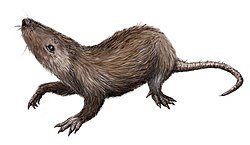| Paulchoffatiidae Temporal range: | |
|---|---|
 | |
| Drawing of the skull of Paulchoffatia | |
| Scientific classification | |
| Kingdom: | Animalia |
| Phylum: | Chordata |
| Class: | Mammalia |
| Order: | † Multituberculata |
| Suborder: | † Plagiaulacida |
| Family: | † Paulchoffatiidae Hahn, 1969 |
| Genera | |
Paulchoffatiidae is a family of extinct mammals that lived predominantly during the Late Jurassic epoch, though a couple of genera are known from the Early Cretaceous. Fossils have been reported from Europe (Portugal, Spain, Germany, and England). Paulchoffatiids were members of the order Multituberculata. They were relatively early representatives and are within the informal suborder of "Plagiaulacida". The family was named by G. Hahn in 1969, and it honors the Portuguese geologist Léon Paul Choffat.
Contents
The most productive fossil site for Paulchoffatiids has been Guimarota, Portugal. Remains from this locality are generally diagnosed on the basis of lower or upper jaws. In only one instance, that of Kuehneodon , has it been possible to match the two up. Some of the lower jaws probably represent the same animals as some of the upper, so the diversity of Paulchoffatiids is very possibly exaggerated. As the site is now a flooded, disused coalmine, further excavations are highly unlikely. However, other locations may yet provide more clarity.
The Paulchoffatiids have been further arranged into two subfamilies and a couple of other genera.

